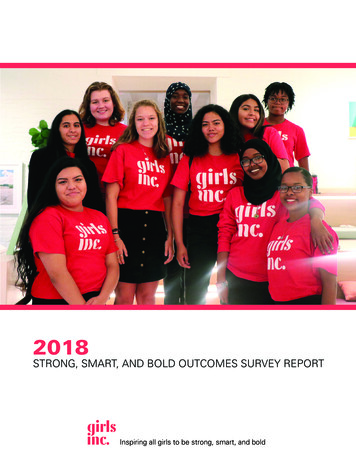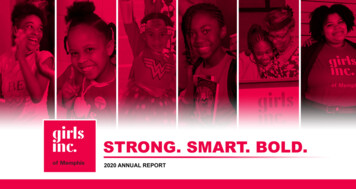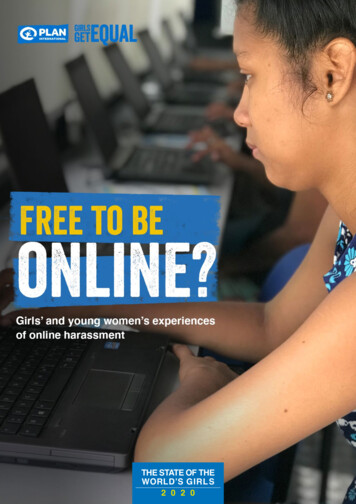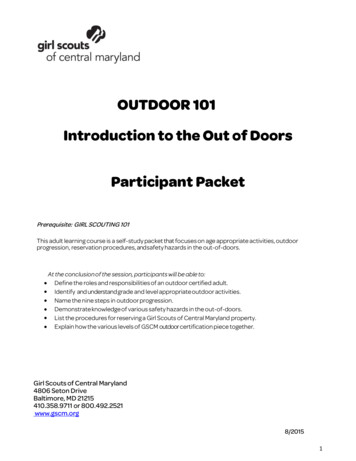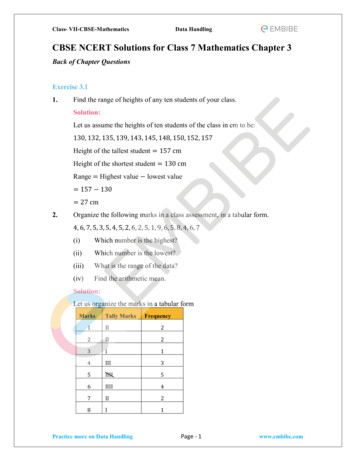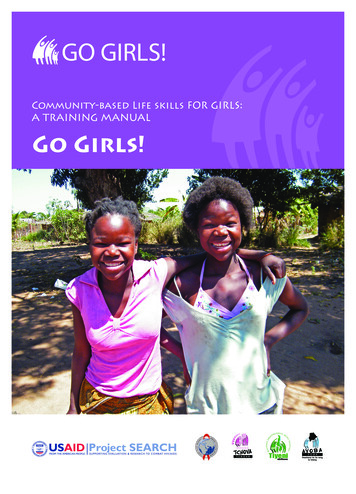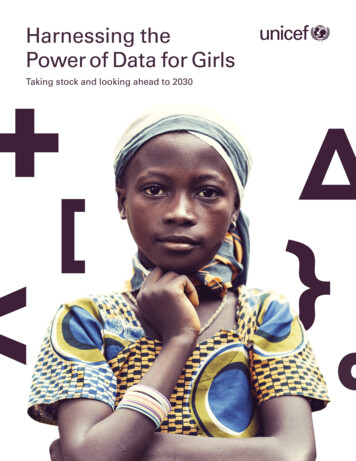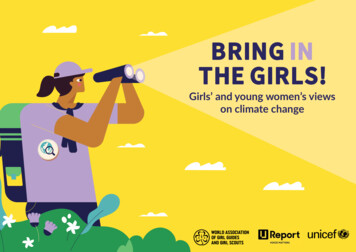
Transcription
BRING INTHE GIRLS!Girls’ and young women’s viewson climate change
BRING IN THE GIRLS!Girls’ and young women’s viewson climate changeBring In the Girls!: Girls’ and young women’s views on climate changeMain authors: Inês Maria Gonçalves (WAGGGS) and Bárbara MéndezData analysis: Ana María RestrepoRevision and technical supervision: Juan Pablo Arguello, U-Report Digital Specialist (UNICEF)This document was produced by the World Association of Girl Guides and Girl Scouts (WAGGGS)with the support of the United Nations Children’s Fund (UNICEF) and U-Report.This publication may be reproduced for use in research, advocacy and education only, provided thesource is acknowledged. This publication should not be reproduced for other purposes without theprior written permission of WAGGGS (comms@wagggs.org).Suggested citation: World Association of Girl Guides and Girl Scouts, Bring In the Girls!: Girls’ andyoung women’s views on climate change, WAGGGS, London, 2022WAGGGS and UNICEF value the voices of young people and seek to recognise their experiences andopinions. This report is considered a reliable reflection of what girls and young women have sharedthrough this consultation. However, it should not be used as a single source of information but ratheras a complement to statistically robust research on this topic.The data presented is not statistically representative of girls and young women globally, or in anyspecific country or region. Sampling stratification and post-stratification weighting were not applied.The statements in this publication are the views of the girls and young women consulted and do notnecessarily reflect the policies or the views of WAGGGS, UNICEF and U-Report.Graphic design: Mariana Bucio World Association of Girl Guides and Girls Scouts (WAGGGS)London, 2022 Sharmin Banu
CONTENTSSUMMARY.4WHY WE SHOULD LISTEN TO GIRLS AND YOUNG WOMEN?Foreword.5LET’S DIVE INTO THE TOPICBackground.6FOR GIRLS, BY GIRLSGirl-led consultation.8HOW DID WE CONSULT GIRLS AND YOUNG WOMEN?Methodology. 10WHO HAVE WE LISTENED TO?Sample. 12WHAT HAVE GIRLS TOLD US ABOUT CLIMATE CHANGE?Result analysis. 13HOW ARE GIRL GUIDES AND GIRL SCOUTS ENGAGING WITH CLIMATECHANGE?Impact of Girl Guiding and Girl Scouting. 23WHAT ARE GIRLS ASKING FOR?Calls for action. 25WHO ARE WE?Join us in amplifying girls’ voices. 27THANK YOU!Acknowledgments. 28 Fehizoro Ny Fitiavana
SUMMARY33,523girls andyoung women90countries18KEY FINDINGSlanguagesResearch suggests that girls and young women are the hardest hit by climatechange1. Despite this, their voices are not adequately represented in climatediscussions, resulting in policies that do not address their specific needs.AwarenessThis must change.Girls agencyNearly 3 out of 10 girls and young women consulted are not familiar withclimate change and 1 out of 10 has never heard about it.Climate change has a disproportionate impact on girls and young women.However, more than half of them (56%) say that they were unaware of thisfact. After learning this, 8 out of 10 girls and young women still think girlsaround the world have the power to tackle climate change.In early 2022, WAGGGS and UNICEF launched a U-Report poll to amplify girls’voices on climate change. In total, 33,523 girls and young women from 90 countrieswere consulted on this topic and its gender dimension.Listening to girlsWhat they told us is critical to better understand girls’ views and experiences.Although girls and women are already playing a vital role in responding to climatechange, they are often excluded from the conversation. More needs to be done toensure all girls are heard, supported, and empowered to take the lead.6 out of 10 girls and young women say their government has neverconsulted them on policies related to the environment.Empowering spacesGirls and young women around theworld have raised their voices.It’s time to #BringIntheGirls to theclimate discussion!1Almost all Girl Guides and Girl Scouts (9 in 10) believe that their journey in themovement encouraged them to take action and protect the environment.Girls as drivers of changeMost girls have already taken action to tackle climate change. 52% havedone it a few times, while 28% have taken action very often.Gender and the Environment: Building Evidence and Policies to Achieve the SDGs, OECD, 2021Poverty and the Environment/Climate Change. UNDP-UNEP Poverty-Environment Initiative, 2018Gender, Climate Change and Health,WHO, 2014.Summary4#BringInTheGirls
WHY WE SHOULD LISTEN TO GIRLS ANDYOUNG WOMEN?ForewordHi! My name is Itzel, I am 15 years old and I am from Mexico.In my role as Climate Poll Ambassador, I went to an underprivileged community to consult girls on their views about climate change. Some girls I consulted didn’t evenknow what climate change was. Even less that it makes girls more vulnerable and that they suffer the hardest consequences when a climate crisis hits. I found thesituation shocking! Just imagine how many more girls are in the same situation.From the poll development to the compilation of the data, I’ve learned a lot of things. I’ve seen further into the reality of climate change around the world. I’ve learnedthat each girl and young woman sees climate change in a unique way, based on her own point of view and her own life experiences.This consultation also made other girls more aware of their potential. They were able to think about what they can do, and I encouraged them to make those changeshappen.As Girl Guides and Girl Scouts, we have the opportunity to listen to other girls and educate them about climate change. My mission is to continue to share knowledgeand help other girls reach their goals and raise their voices.We have the power to make a difference: starting with little actions in our own communities. Together, we can make our world a peaceful, equal, and livable place.LISTEN TO GIRLS!We have things to say!Itzel López Moreno, member of the consultationco-design team and Climate Poll AmbassadorForeword5#BringInTheGirls
LET’S DIVE INTO THE TOPICBackgroundDisproportionate impact on girls and womenWhat is Climate Change?4 out of 5 people displaced by climate change are girls and women.3Climate change refers to long-term shifts in temperaturesand weather on our planet.Human activities (like burning coal, oil and gascreates greenhouse gas emissions that act like a blanketaround the Earth, trapping the sun’s heatand raisingtemperatures.Around the world, girls are the first to leave school to support theirfamilies and take on extra domestic chores created by new climateconditions. Girls are also less likely to re-enroll in school than boysafter an environmental crisis.4)When water is scarce, women and girls are forced to travel longdistances, often in unsafe conditions, to reach water and bring ithome. This also exposes them to increased risks of gender-basedviolence.5As a consequence, the weather becomes more extremeand unpredictable, impacting our planet and those wholive in it.2Climate emergencies, like droughts and floods, can make girls missschool during their periods due to the lack of water and adequatesanitation for menstrual hygiene management.6During severe weather conditions, girls in vulnerable households aremore likely to drop out of education and be forced into marriage7By 2025, climate change could keep more than 12 million girls fromcompleting their education every year.8United Nations - What Is Climate Change?The Climate Crisis is a Child Rights Crisis: Introducing the Children’s Climate Risk Index. UNICEF, 20214A greener, fairer future: Why leaders need to invest in climate and girls’ education. Malala Fund, 20215The Climate Crisis is a Child Rights Crisis: Introducing the Children’s Climate Risk Index. UNICEF, 20216When Coping Crumbles Drought in India 2015-16: A Rapid Assessment of the Impact of Drought on Children and Women in India. UNICEF, 20162378BackgroundGirls’ rights in climate strategies. Plan International, 2019A greener, fairer future: Why leaders need to invest in climate and girls’ education. Malala Fund, 20216#BringInTheGirls
“Most of the time, we do not identify climate change as a hugechallenge that we are facing. But, actually, it is.Climate change affects our studies and our ways of living. Our societymade us believe that it’s girls’ responsibility to fetch wate r or collectfirewood. So as the weather changes, we are always at risk of missingschool and taking over those responsibilities.”Diane Umuhire, 16-year-old girl from RwandaGirls and women are left outLess than 2% of national climate strategies mention girls.9While 43% Nationally Determined Contributions (NDC) reference women orgender, it is largely in the context of women as a vulnerable group rather thancontributors to climate action.10Only a third of 192 national energy frameworks from 137 countries includesome gender considerations. In most of these, women are characterized aspotential beneficiaries, but rarely as agents of change.11In the year the Paris Agreement was agreed, only 35% of national delegateswere women.12Girls’ Education in Climate Strategies: Opportunities for Improved Policy and Enhanced Action inNationallyDeterminedw Contributions, Brookings Institution., Plan International and UNICEF, 201910Girls’ Education in Climate Strategies: Opportunities for Improved Policy and Enhanced Action inNationallyDetermined Contributions, Brookings Institution., Plan International and UNICEF, 201911Energizing equality: the importance of integrating gender equality principles in national energypoliciesand frameworks. International Union for the Conservation of Nature and others, 201712Wedo - Women’s Delegate Fund.9 Association des Guides du Rwanda7#BringInTheGirls
FOR GIRLS, BY GIRLSGirl-led consultationWe know that climate change cannot be faced without the voices and leadership of girls and youngwomen. The same applies for youth consultation! To better understand what they think aboutclimate change, girls and young women were the ones showing the way forward.Co-designFive girls and young women from Rwanda, Nigeria, India, Mexico and South Africa were invited to co-designthis consultation side by side with WAGGGS.“If we had the magic power to consult all girls in the worldon climate change, what would we like to know from theirexperiences?”Sharmin, Mimi, Bukky, Itzel and JasminCo-design teamThis team explored the topic together and identified what is missing in the climate changeconversation from a girl’s perspective. They then wrote a questionnaire, asking more than 80 girlsfrom 13 countries to vote on the questions they believed were the most important to include inthe consultation.This was how the poll was created! Sofia ValeGirl-led consultation8#BringInTheGirls
Climate Poll Ambassadors33 girls and young women from Australia, Lebanon, Kenya, Saint Lucia, India, the Philippines, Madagascar, Mexico, Nigeria, South Africa,Rwanda, Sri Lanka, the United Kingdom and Venezuela were appointed to lead this consultation.Their passion for the environment and amplifying young people’s voices were the main driving forces behind the data collectionand analysis. They:Invited and mobilised girls and young women to participate in the U-Report poll - friends, family, colleaguesand everyone in their networks!Handed out paper-versions of the poll to girls in schools, Girl Guiding and Girl Scouting units andunderprivileged communities.Raised awareness about climate change and facilitated learning spaces with the girls consulted.Selected individual responses (from the qualitative data) from girls in their countries. Sylvia MeinGirl-led consultation9
HOW DID WE CONSULT GIRLS ANDYOUNG WOMEN?MethodologyThe consultation took place, both online and offline, between January and February2022. We asked 15 questions about climate change and its link to gender equality ina way that everyone could understand - making it feel more like a conversation!OnlineA U-Report poll was available in 18 languages and distributed via SMS, WhatsApp,Facebook Messenger, and Viber. It was launched on U-Report Global and 11U-Report national platforms:Argentina, Bangladesh, Bolivia, Brazil, India, Indonesia, Mexico, Nigeria, Iraq,Italy, and Tanzania.What is U-Report?U-Report is UNICEF’s flagship digital platformto engage children, adolescents, and youth inprogramme priorities, emergency response, andadvocacy actions. It is an interactive tool thatconnects young people with stakeholders andallows them to amplify their voices on issuesthat matter to them. Sharmin Banu MSMethodology10#BringInTheGirls
OfflinePaper surveys were distributed by Climate Poll Ambassadors in 10 countries toreach girls and young women less likely to know and participate in the U-Reportpoll - mainly because of low internet access or not being able to use a digitaldevice.Australia, India, Kenya, Lebanon, Madagascar, Mexico, Nigeria, Saint Lucia,United Kingdom, and Venezuela.This report shares the views of female participants who agreed to be part of theconsultation and responded to questions about their age, gender, if they wereGirl Guides, and our first question about climate change.How did we get to the results?We explored the data from a global perspective and looked for differencesbetween age groups, geographic regions and those who were part of the GirlGuiding and Girl Scouting movement.Only the quantitative answers13 were consolidated. Qualitative answers14 arepresented as individual opinions.Ready to take a look?1314Answers to questions that had options to choose fromAnswers to questions where respondents could share their unique views Sharmin Banu MSMethodology11#BringInTheGirls
WHO HAVE WE LISTENED TO?Sample33,523 girls and young women from 90 countries participated in the consultation. Of these:46%54%10-17 yearsold girls92%18-25 years oldyoung women8%took thepoll online43%participatedoffline57%Girl Guides &Girl Scoutswere notMiddle East & North Africa1,5% - 492North AmericaEurope & Central Asia0,0% - 100,3% - 105East Asia & Pacific24,1% - 8,074Latin America & Caribbean15,7% - 5,272South AsiaSub-Saharan Africa43,8% - 14,67914,6% - 4,891This map is stylised and it is not to scale. It does not reflect a position by WAGGGS, UNICEF and U-Report on the legal status of any country, territory or the delimitation of any frontiers.Sample12#BringInTheGirls
WHAT HAVE GIRLS TOLD USABOUT CLIMATE CHANGE?Result analysis“Climate Change affects everyone in one way oranother. By doing this consultation, we are ableto understand how it affects girls.”Jasmin, 21-year-old member of the co-design team from South AfricaResult analysis13#BringInTheGirls
How familiar are you with climate change?50%44%Zooming in40%30%20%Girls and young women in Europe and CentralAsia (28%) are more likely to feel very confidentabout their climate change knowledge comparedto their peers worldwide (an average of 19%).28%9%10%0%Almost twice as many girls and young womenin the Middle East and North Africa (17%) havenever heard of climate change compared to theglobal average (9%).19%I'm notI could talk aboutvery familiarit for hoursI have neverheard of itI know whatit isAlmost half of the girls and young women consulted (44%) know what climatechange is, followed by those who are not very familiar with it (28%).19% say they could talk about it for hours, while a small group of girls and youngwomen (9%) have never heard of it.Result analysis14#BringInTheGirls
Do you think climate change is beingtaken as seriously as COVID?Why is that?“Because people are not seeing instant results of climatechange in their current lifestyles, and when they actuallynotice, it will be too late.”More than half of girls and young women (57%) believe climate change is nottreated with the same seriousness as COVID.57%60%17-year-old girl from Lebanon50%40%“The government doesn’t take it [climate change]seriously.”34%13-year-old girl from Nigeria30%“I think it is not taken into account because it doesnot imply an imminent threat in the present, unlikeCOVID-19. The consequences of climate change aremore unknown and ignored, although they are affectingmany people.”20%10%0%9%I don't knowNoYes19-year-old young woman from MexicoZooming in“Because it is not within anybody’s economic interests.”Half of the girls (10-17 years old) think that climatechange is not taken as seriously as COVID, apercentage that rises to 63% for girls aged 18 to 25.23-year-old young woman from Greece“The issue of climate change is not getting the sameattention from the media.”A higher percentage of girls and young women whoanswered the online poll (59%) think climate changeis not taken as seriously as COVID than those whoparticipated offline (35%).15-year-old girl from IndonesiaResult analysis15#BringInTheGirls
In the place where you live, who carries out more activities to protect the environment?(eg: recycling, saving energy, planting, etc)More than half of girls and young women (52%) say that both women and mencarry out activities to protect the environment equally.Zooming in1 in 4 girls and young women (24%) report that women carried out moreactivities to protect the environment in the place where they live.A greater number of girls and young women whoare Girl Guides (60%) have the perception that bothwomen and men are equally involved in activities toprotect the environment compared to those who arenot (45%).60%52%Most girls and young women around the worldbelieve that both women and men are equallyinvolved in such activities. However, in the MiddleEast and North Africa region, 4 of 10 girls and youngwomen say neither of them are involved. This result isdouble the global average (19%).50%40%30%24%19%20%10%0%Result analysis5%Both equallyFemalemembersMalemembersNo one16#BringInTheGirls
Have you taken action to tackle climatechange? (eg: taking part in a campaign,educating friends and family, joiningenvironmental activities, etc)For those who answered yes, how doadults around you react when you takethose actions? They.One-third of girls (34%) who have taken action to address climate changereport that when they do, adults close to them join in. Another third (33%) aresupported but say adults don’t join them in those activities.Good news! Most girls and young women (80%) have taken action to tackleclimate change. However, 16% of the girls and young women consulted told usthey have not yet engaged in activities that tackle climate %I don't know33%15%28%30%34%35%0%Discourage meNoDon't reactmuchJoin me!Support mebut don't joinZooming in“I have not done anything but ifI will get a chance I will surely try.”Girls and young women taking the online poll (35%) report that adultsclose to them join their initiatives compared to those consulted offline(27%).13-year-old girl from IndiaResult analysisGirls and young women in the South Asian region report the mostsupport from adults in their actions to address climate change. Nearlyhalf of the respondents (45%) report that adults join in their activities.17#BringInTheGirls
Where do you prefer to learn about climate change?Almost half of the girls and young women who participated in the poll (44%)prefer learning about climate change in all of the ways suggested, including inschool, through family and friends, non-formal spaces, and online.Zooming inGirls and young women from the South Asia (27%) and SubSaharan Africa (23%) regions are more likely to want to learnabout climate change in school.Of the options presented, girls and young women have expressed a preferenceto learn about climate change mostly at school (20%), followed by informalspaces such as youth clubs, Girl Guiding or Scouting communities (15%) andonline settings (15%).50%The preference for online learning is highest in the East Asiaand Pacific region (24%) and Europe and Central Asia (21%).Most of the girls and young women who prefer to learnabout climate change in non-formal spaces are from theSub-Saharan Africa region (20%) and Latin America and theCaribbean (18%).44%40%30%20%20%15%10%0%Result analysis4%All of theaboveAtschoolFrom In non-formalfriendsspacesor family15%2%NoneOnline18#BringInTheGirls
Did you know that girls and young women are the most affected by climate change?More than half of the girls and young women who participated in the poll (56%)said they were not aware of the disproportionate impact of climate change ingirls and young women’s lives.Yes44%Result analysisZooming inGirls and young women who are not Girl Guides are the mostunaware of this situation. Nearly 6 in 10 (63%) said they donot know that girls and young women are the most affectedby climate change.No, is thatreally true?The highest proportion of those who were not aware of thegendered impact of climate change live in Latin America andthe Caribbean, where 7 out of 10 girls and young womenreport not knowing about it.56%19#BringInTheGirls
Still, do you think girls and youngwomen have the power to reduceclimate change?They shared their views on why and howgirls can be drivers of climate actionThe poll provided some information about the disproportionate impact ofclimate change in girls’ and young women’s lives. After learning about that,nearly 8 out of 10 respondents (79%) still believe that girls have the powerto mitigate it.“We know how to get ourselves out of any adversesituation, make our own place where they don’t want us toenter, and change the things that don’t seem right to us.The creativity within each girl and young woman will be keyto creating change.”Not so much21.4%23-year-old young woman from Argentina“We can educate and empower each other.”17-year-old girl from Sri LankaYes78.6%“Leading by example is always a great way to get started.Showing to people - our friends, family, colleagues different ways to live more sustainably. It all starts withourselves and the example we set for those around us.”18-year-old young woman from Portugal“If we work together, we will be taking the first step towardschange.”13-year-old girl from Trinidad and TobagoResult analysis20#BringInTheGirls
Those who said “no” explained the reasons behind their response:“Unfortunately, machismo still has a stronghold inour society, and women and girls cannot always be asinfluential as they would like to be.”Zooming inThe consultation revealed that girls and young women whoresponded online are more likely to believe in their abilityto reduce climate change than those who participatedoffline (82% versus 53%).23-year-old young woman from Bolivia“Where I live, we can’t even decide on how to cut ourown hair, [tackling climate change] is too big to do.”Girl Guides are more confident in their ability to influenceclimate change than those who are not Girl Guides (82%versus 75%).23-year-old young woman from India“In my country, the voices of girls are the least heard.”16-year-old girl from Madagascar“In our community, females are oppressed so they areinhibited from taking any action without the male’sapproval.”23-year-old young woman from LebanonResult analysis21#BringInTheGirls
Has your government ever asked your opinion on policies relatedto the environment?6 out of 10 girls and young women (62%) say their governments never consultedthem on policies related to the environment.In contrast, 23% say they have been asked, with 15% saying they have beenasked a few times and 8% only once.80%70%Zooming in62%In South Asia and Sub-Saharan Africa, 28% of girls and youngwomen say that the government has asked their opinions onenvironmental policies (28% in both regions). This representsa higher perception of youth consultation compared to theglobal average (23%).60%50%40%In the Middle East and North Africa, only 6% of girls andyoung women report that their governments consult withthem.30%20%16%15%8%10%0%Result analysisI don't knowNeverYes, once22#BringInTheGirls
HOW ARE GIRL GUIDES AND GIRL SCOUTSENGAGING WITH CLIMATE CHANGE?Impact of Girl Guiding and Girl ScoutingMost of the girls and young women consulted who are Girl Guides (88%)say being one encouraged them to fight climate change and protect theenvironment.No11.7%They shared what they’ve done so far:“We have people working as a team andinforming people about climate change.”21-year-old Girl Guide from Nigeria“I opt for plant-based food.”13-year-old Girl Guide from Australia“I have learned more about this topic.”15-year-old Girl Guide from Venezuela“By raising awareness.”22-year-old Girl Guide from Libya88.3%Result analysis23#BringInTheGirls
Data also shows a strong relationship between being a Girl Guide and thecommitment to climate action and environmental protection.Greater awareness of climate change21% of Girl Guides report being able to talk for hours about climate change compared to 18% ofrespondents that do not consider themselves Girl Guides.Furthermore, there is a higher perception of its gender dimension among Girl Guides, with50% reporting knowing that climate change disproportionately affects girls and young womencompared to 37% that are not Girl Guides.Increased agencyGirl Guides take more action on climate change: 84% have told us they are already taking action incomparison to 76% of their counterparts.More than 1 in 3 Girl Guides (35%) say they do it very often, compared to 21% of respondentswho are not Girl Guides.Greater intergenerational collaboration43% of Girl Guides report support from surrounding adults when carrying out activities againstclimate change, compared to 24% who are not Girl Guides.Increased exposure to youth consultation opportunities28% of Girl Guides say they were consulted by their governments, compared to 17% of those whoare not Girl Guides.Result analysis24#BringInTheGirls
WHAT ARE GIRLS ASKING FOR?Calls for actionWe need to #BringInTheGirls in the climate discussion.Climate change is the defining challenge of our time and poses a critical threat toour future.Girls and young women worldwide have shared four powerful ways to do it:Girls and young women are already on the frontline of this crisis. Far from beingpassive victims, they are taking action to respond to its effects.Put girls at the centerInvest in environmental policies that consider and prioritise girls and youngwomen, especially indigenous girls, girls with disabilities, and those living inrural areas.Yet, they continue to face barriers to fully exercise their right to participation.From not being consulted to being largely absent from governments’ climateaction plans: girls’ potential as drivers of climate action is underestimated.Nothing about girls without girlsThe world needs to ensure that girls and young women have spaces to raise theirconcerns, share their experiences and transform the challenges they face intosolutions. We all need to guarantee that girls can learn about climate change: whyit’s happening, what are the effects, and what they can do to tackle it.Ensure their voices and leadership are part of the decisions that impacttheir countries and communities when it comes to climate change, includingduring the development of national climate adaptation plans.Education is key for changeBecause when they do,girls are unstoppable.Make climate change accessible for all children and young people, include itin the school curriculum and invest in non-formal learning spaces.Partner with girlsSupport youth movements and invest in building girls’ capacity so they canbe empowered to take the lead and contribute to climate action.Calls for action25#BringInTheGirls
“Have the political courage to take action against largepolluting companies instead of focusing only on citizens’actions.”What would you like decision-makers to do?“Make sure that everyone participates and plays a rolein climate change. If everyone played a role, we all canmake a big change rather than opinions being biased foronly one gender.”22-year-old young woman from France“Inform more people about the topic - in the media, tochildren in schools, on the internet, in workplaces. Sothat we are all aware of what is happening and what wecan do to improve it.”15-year-old girl from Canada“Engage girls and young women in the fight againstclimate change”.19-year-old young woman from Honduras17-year-old girl from Madagascar“Make solutions instead of promises.”“Switch to sustainable transport, invest in renewableenergy and improve farming.”13-year-old girl from the Philippines14-year-old girl from Dominica“Teach young girls about climate change in order to learnwhat they can do to fight climate change and protectthe environment.”20-year-old young woman from RwandaJoin us in spreading the word!“Adopt laws and severe penalties for those who destroythe environment deliberately.”Share the results of this c
BRING IN THE GIRLS! Bring In the Girls!: Girls' and young women's views on climate change Main authors: Inês Maria Gonçalves (WAGGGS) and Bárbara Méndez Data analysis: Ana María Restrepo Revision and technical supervision: Juan Pablo Arguello, U-Report Digital Specialist (UNICEF) This document was produced by the World Association of Girl Guides and Girl Scouts (WAGGGS)


